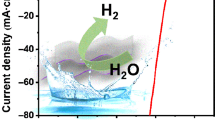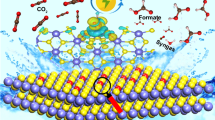Abstract
Seeking catalysts with high electrocatalytic activity for ambient-condition N2 reduction reaction (NRR) remains an ongoing challenge due to the chemical inertness of N2. Herein, defect-rich WS2 nanosheets (WS2−x) were designed as an efficient electrocatalyst for NRR, which were prepared via vulcanizing the oxygen-vacancy-rich tungsten oxide in a vacuum tube. The sulfur defects were conducive to the adsorption and activation of N2. In neutral electrolyte of 0.1 mol L−1 Na2SO4 at −0.60 V vs. reversible hydrogen electrode, such WS2−x offered a high Faradaic efficiency of 12.1% with a NH3 generation rate of 16.38 µg h−1 mgcat−1.
摘要
由于N2的化学惰性, 实现高效的N2还原反应(NRR)亟需发展高活性的电催化剂. 本文中, 我们设计了富含缺陷的WS2纳米片 (WS2−x)作为NRR的有效电催化剂, 该催化剂是在合成具有氧空位的二维WO3纳米片的基础上通过真空封管法硫化方法制备而成. 这种单层的WS2纳米片是由S-W-S夹心阵列组成的类石墨烯结构, 具有高电子迁移率, 中等带隙和丰富的活性位点, 同时硫缺陷有利于N2的吸附和活化. 在相对于可逆氢电极为−0.60 V的Na2SO4 (0.1 mol L−1)中性电解质中, 使用该WS2−x催化剂可得到12.1%的法 拉第效率和16.38 µg h−1 mgcat.−1的产氨量.
Similar content being viewed by others
References
Liu D, Zhang G, Ji Q, et al. Synergistic electrocatalytic nitrogen reduction enabled by confinement of nanosized Au particles onto a two-dimensional Ti3C2 substrate. ACS Appl Mater Interfaces, 2019, 11: 25758–25765
Rafiqul I, Weber C, Lehmann B, et al. Energy efficiency improvements in ammonia production—perspectives and uncertainties. Energy, 2005, 30: 2487–2504
Rosca V, Duca M, de Groot MT, et al. Nitrogen cycle electrocatalysis. Chem Rev, 2009, 109: 2209–2244
Service RF. New recipe produces ammonia from air, water, and sunlight. Science, 2014, 345: 610
Brown KA, Harris DF, Wilker MB, et al. Light-driven dinitrogen reduction catalyzed by a CdS:nitrogenase MoFe protein biohybrid. Science, 2016, 352: 448–450
Guo C, Ran J, Vasileff A, et al. Rational design of electrocatalysts and photo(electro)catalysts for nitrogen reduction to ammonia (NH3) under ambient conditions. Energy Environ Sci, 2018, 11: 45–56
Lu Y, Yang Y, Zhang T, et al. Photoprompted hot electrons from bulk cross-linked graphene materials and their efficient catalysis for atmospheric ammonia synthesis. ACS Nano, 2016, 10: 10507–10515
Tanabe Y, Nishibayashi Y. Developing more sustainable processes for ammonia synthesis. Coord Chem Rev, 2013, 257: 2551–2564
Bao D, Zhang Q, Meng FL, et al. Electrochemical reduction of N2 under ambient conditions for artificial N2 fixation and renewable energy storage using N2/NH3 cycle. Adv Mater, 2017, 29: 1604799
Guo X, Du H, Qu F, et al. Recent progress in electrocatalytic nitrogen reduction. J Mater Chem A, 2019, 7: 3531–3543
Liu G, Cui Z, Han M, et al. Ambient electrosynthesis of ammonia on a core-shell-structured Au@CeO2 catalyst: Contribution of oxygen vacancies in CeO2. Chem Eur J, 2019, 25: 5904–5911
Liu HM, Han SH, Zhao Y, et al. Surfactant-free atomically ultra-thin rhodium nanosheet nanoassemblies for efficient nitrogen electroreduction. J Mater Chem A, 2018, 6: 3211–3217
Wang J, Yu L, Hu L, et al. Ambient ammonia synthesis via palladium-catalyzed electrohydrogenation of dinitrogen at low overpotential. Nat Commun, 2018, 9: 1795
Kugler K, Luhn M, Schramm JA, et al. Galvanic deposition of Rh and Ru on randomly structured Ti felts for the electrochemical NH3 synthesis. Phys Chem Chem Phys, 2015, 17: 3768–3782
Han J, Ji X, Ren X, et al. MoO3 nanosheets for efficient electrocatalytic N2 fixation to NH3. J Mater Chem A, 2018, 6: 12974–12977
Ren X, Cui G, Chen L, et al. Electrochemical N2 fixation to NH3 under ambient conditions: Mo2 N nanorod as a highly efficient and selective catalyst. Chem Commun, 2018, 54: 8474–8477
Zhang S, Gong W, Lv Y, et al. A pyrolysis-phosphorization approach to fabricate carbon nanotubes with embedded CoP nanoparticles for ambient electrosynthesis of ammonia. Chem Commun, 2019, 55: 12376–12379
Qiu W, Xie XY, Qiu J, et al. High-performance artificial nitrogen fixation at ambient conditions using a metal-free electrocatalyst. Nat Commun, 2018, 9: 3485
Liu Y, Su Y, Quan X, et al. Facile ammonia synthesis from electrocatalytic N2 reduction under ambient conditions on N-doped porous carbon. ACS Catal, 2018, 8: 1186–1191
Chen GF, Cao X, Wu S, et al. Ammonia electrosynthesis with high selectivity under ambient conditions via a Li+ incorporation strategy. J Am Chem Soc, 2017, 139: 9771–9774
Kong W, Zhang R, Zhang X, et al. WO3 nanosheets rich in oxygen vacancies for enhanced electrocatalytic N2 reduction to NH3. Nanoscale, 2019, 11: 19274–19277
Jin H, Li L, Liu X, et al. Nitrogen vacancies on 2D layered W2N3: A stable and efficient active site for nitrogen reduction reaction. Adv Mater, 2019, 31: 1902709
Zhao W, Ghorannevis Z, Chu L, et al. Evolution of electronic structure in atomically thin sheets of WS2 and WSe2. ACS Nano, 2013, 7: 791–797
Ding Y, Zheng W, Lin Z, et al. Raman tensor of layered WS2. Sci China Mater, 2020, 63: 1848–1854
Meng R, Jiang J, Liang Q, et al. Design of graphene-like gallium nitride and WS2/WSe2 nanocomposites for photocatalyst applications. Sci China Mater, 2016, 59: 1027–1036
Kong D, Qiu X, Wang B, et al. WS2 nanoplates embedded in graphitic carbon nanotubes with excellent electrochemical performance for lithium and sodium storage. Sci China Mater, 2018, 61: 671–678
Wang Q, Lei Y, Wang D, et al. Defect engineering in earth-abundant electrocatalysts for CO2 and N2 reduction. Energy Environ Sci, 2019, 12: 1730–1750
Chee SS, Oh C, Son M, et al. Sulfur vacancy-induced reversible doping of transition metal disulfides via hydrazine treatment. Nanoscale, 2017, 9: 9333–9339
Salehi S, Saffarzadeh A. Atomic defect states in monolayers of MoS2 and WS2. Surf Sci, 2016, 651: 215–221
Yao X, Chen Z, Wang Y, et al. Activated basal planes of WS2 by intrinsic defects as catalysts for the electrocatalytic nitrogen reduction reaction. J Mater Chem A, 2019, 7: 25961–25968
Ma X, Hu J, Zheng M, et al. N2 reduction using single transition-metal atom supported on defective WS2 monolayer as promising catalysts: A DFT study. Appl Surf Sci, 2019, 489: 684–692
Lei F, Sun Y, Liu K, et al. Oxygen vacancies confined in ultrathin indium oxide porous sheets for promoted visible-light water splitting. J Am Chem Soc, 2014, 136: 6826–6829
Wu LM, Seo DK. New solid-gas metathetical synthesis of binary metal polysulfides and sulfides at intermediate temperatures: Utilization of boron sulfides. J Am Chem Soc, 2004, 126: 4676–4681
Guo Y, Yao Z, Timmer BJJ, et al. Boosting nitrogen reduction reaction by bio-inspired FeMoS containing hybrid electrocatalyst over a wide pH range. Nano Energy, 2019, 62: 282–288
Zhu D, Zhang L, Ruther RE, et al. Photo-illuminated diamond as a solid-state source of solvated electrons in water for nitrogen reduction. Nat Mater, 2013, 12: 836–841
Zhang X, Liu Q, Shi X, et al. TiO2 nanoparticles-reduced graphene oxide hybrid: an efficient and durable electrocatalyst toward artificial N2 fixation to NH3 under ambient conditions. J Mater Chem A, 2018, 6: 17303–17306
Kim HU, Kanade V, Kim M, et al. Wafer-scale and low-temperature growth of 1T-WS2 film for efficient and stable hydrogen evolution reaction. Small, 2020, 16: 1905000
Wang J, Huang J, Huang S, et al. Rational design of hierarchical SnS2 microspheres with S vacancy for enhanced sodium storage performance. ACS Sustain Chem Eng, 2020, 8: 9519–9525
Zhang G, Ji Q, Zhang K, et al. Triggering surface oxygen vacancies on atomic layered molybdenum dioxide for a low energy consumption path toward nitrogen fixation. Nano Energy, 2019, 59: 10–16
Jia K, Wang Y, Qiu L, et al. TiS2 nanosheets for efficient electrocatalytic N2 fixation to NH3 under ambient conditions. Inorg Chem Front, 2019, 6: 1986–1989
Li P, Fu W, Zhuang P, et al. Amorphous Sn/crystalline SnS2 nanosheets via in situ electrochemical reduction methodology for highly efficient ambient N2 fixation. Small, 2019, 15: 1902535
Wei P, Xie H, Zhu X, et al. CoS2 nanoparticles-embedded N-doped carbon nanobox derived from ZIF-67 for electrocatalytic N2-to-NH3 fixation under ambient conditions. ACS Sustain Chem Eng, 2020, 8: 29–33
Wang H, Yu H, Wang Z, et al. Electrochemical fabrication of porous Au film on Ni foam for nitrogen reduction to ammonia. Small, 2019, 15: 1804769
Jiang J, Liu Q, Zeng C, et al. Cobalt/molybdenum carbide@N-doped carbon as a bifunctional electrocatalyst for hydrogen and oxygen evolution reactions. J Mater Chem A, 2017, 5: 16929–16935
Acknowledgements
This work was supported by the National Natural Science Foundation of China (21874079), the Natural Science Foundation for Outstanding Young Scientists of Shandong Province (ZR2018JL011), the Key R&D Project of Shandong Province (GG201809230180), Taishan Scholars Program of Shandong Province (tsqn201909088), the Outstanding Youth Innovation Team of Universities in Shandong Province (2019KJA027), and the Science & Technology Fund Planning Project of Shandong Colleges and Universities (J16LA13 and J18KA112).
Author information
Authors and Affiliations
Contributions
Author contributions Xu Y and Li J conceived the idea and wrote the manuscript. Ma L and Kong W carried out the synthesis, characterization and performance measurements and wrote the manuscript. Jin Z, Han Y, Sun J, and Liu J participated in the general discussion. Liu M contributed to the data analysis. Xu Y and Li J revised the manuscript.
Corresponding authors
Ethics declarations
Conflict of interest The authors declare no conflict of interest.
Additional information
Liangyu Ma is a Master candidate under the guidance of Professor Yuanhong Xu at Qingdao University. Her research focuses on the synthesis of transition metal nanomaterials and their application in nitrogen reduction.
Wenhan Kong received his MSc degree from Qingdao University in 2020. Currently, he is pursuing PhD degree at the South China University of Technology. His research focuses on nitrogen reduction and energy storage in 2D transition metal nanomaterials.
Yuanhong Xu is currently a professor at Qingdao University, China. She received her PhD in analytical chemistry from Changchun Institute of Applied Chemistry, Chinese Academy of Sciences (2009) supervised by Prof. Erkang Wang. From 2010 to 2011, she obtained the “Humboldt Research Fellowship for Postdoctoral Researchers” and did postdoctoral research in Prof. Hermann Wätzig’s group at TU Braunschweig, Germany. She joined Qingdao University in 2014. Her current scientific interests are in designing quantum dots from 2D materials for biosensors, fluorescent imaging and catalysis.
Jinghong Li is a professor at the Department of Chemistry, Tsinghua University, China. He received his PhD degree from Changchun Institute of Applied Chemistry, Chinese Academy of Sciences in 1996. He joined the faculty of Tsinghua University in 2004. His current research interests include electroanalytical chemistry, bio-electrochemistry and sensors, physical electrochemistry and interfacial electrochemistry, electrochemical materials science and nanoscopic electrochemistry.
Supplementary Information
Rights and permissions
About this article
Cite this article
Ma, L., Kong, W., Liu, M. et al. Sulfur defect-rich WS2−x nanosheet electrocatalysts for N2 reduction. Sci. China Mater. 64, 1910–1918 (2021). https://doi.org/10.1007/s40843-020-1572-3
Received:
Accepted:
Published:
Issue Date:
DOI: https://doi.org/10.1007/s40843-020-1572-3




